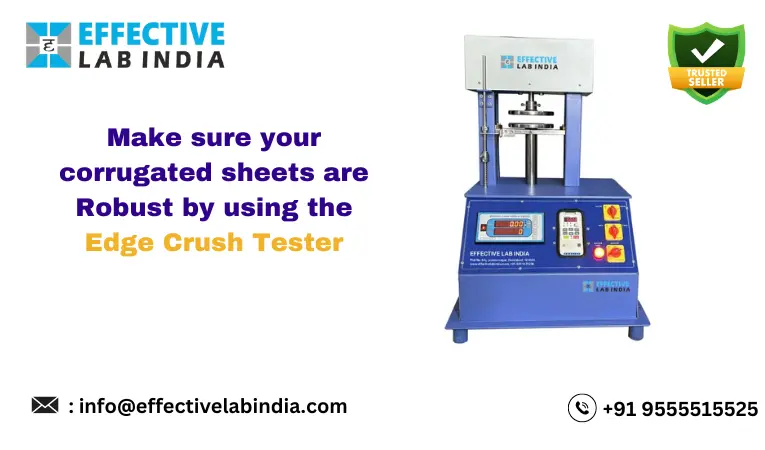When packing goods for storage and shipping, corrugated sheets (a type of corrugated box) are utilized. Manufacturers use these boxes extensively since they are very reasonably priced for the quality that they provide. The quality assessment of their corrugated sheets guarantees the quality of these corrugated boxes. Corrugated boxes, paper bags, and other related products are constructed using these corrugated sheets.
While some testing procedures are taken into account, producers from a variety of industries must ascertain the final packing product’s strength because production is a process of checks and measures. To guarantee that the corrugated boxes’ edges are strong enough to withstand deformation, encasing, or damage while being stored.
Effective Lab India offers manufacturers cutting-edge lab testing equipment known as edge crush testers to address this issue. The instrument is made with the highest engineering standards, taking the operator’s needs into account.
The equipment’s primary purpose is to assess the corrugated sheet’s capacity to bear compression loads applied to it with a constant force from all sides.
Gaining a deeper understanding of the lab testing instrument’s functioning and operation to attain greater accuracy requires working through its functioning module.
Functioning
The edge crush test machine has an operator-friendly design that simplifies the testing procedure and raises the standards of accuracy for the results. As a result, it operates on a basic mechanism.
The ring crush test, edge crush test, and flat crush test are the three different methods that the instrument’s operator or the corrugated sheet producer can use to assess the corrugated sheet’s strength. The device is commonly referred to as an RCT/FCT/ECT machine because of its three-way testing procedure.
Various specimen grippers are available for use with the lab testing apparatus depending on the testing procedure. With the help of these grippers, the operator can complete the 3-way testing procedure more quickly and accurately. The operator must be aware that these tests can only be performed on particular types of sheets, for example, thin-layered specimens are used for the ring crush test, while sheets with three to five plies are required for the edge crush test and five to seven plies for the flat crush test.
The operator can easily modify the parameters from the control panel and start the ECT, RCT, or FCT test when the specimen has been properly positioned in each of its grippers. The specimen is under pressure from the instrument’s compression plate, which can withstand loads up to 100 kg. As a result, the specimen deforms or deflects from its initial state. The compression plate is driven by a lead screw that guarantees smooth movement at a speed of 12.5 mm per minute by standard protocols.
The microprocessor-based digital display first calculates the maximum load the specimen could support before showing the deflection or integration of plies that occurred as a result of the compressive pressure applied to it.
Now that the instrument values are easily recorded, the operator can get even more accuracy-driven outcomes. If there are any uncertainties, the operator can adapt at this phase of production instead of waiting until a later time to conduct the test and suffering significant losses due to mass manufacturing.
The instrument contains advanced features that make it possible for the user to do testing hassle-free and with complete convenience.
Features
The edge crush testing machine is a feature-rich piece of laboratory apparatus that helps packaging sector producers determine the compression strength of corrugated sheets with precision.
The ability of the instrument to perform 3-way testing, which enables the operator to conduct testing on variably layered plies and cover the highest number of sheets in a single instrument, is its most notable feature and the reason it has drawn the greatest number of manufacturers.
Additionally, the apparatus is equipped with several grasping mechanisms that allow the operator to perform the three testing procedures quickly, easily, and accurately.
Moreover, the device is standardized to guarantee accuracy and hassle-free test administration. The criteria of the specified standards that the instrument adheres to mention the movement of the compression plate at a speed of 12.5 mm.
A highly sophisticated microprocessor-based digital display is another feature of the edge crush test machine that guarantees the device displays precise results following each testing measure. Feather touch control buttons on the digital display facilitate one-handed testing and enable the operator to make use of the memory hold function, which records the last nine readings of the result.

